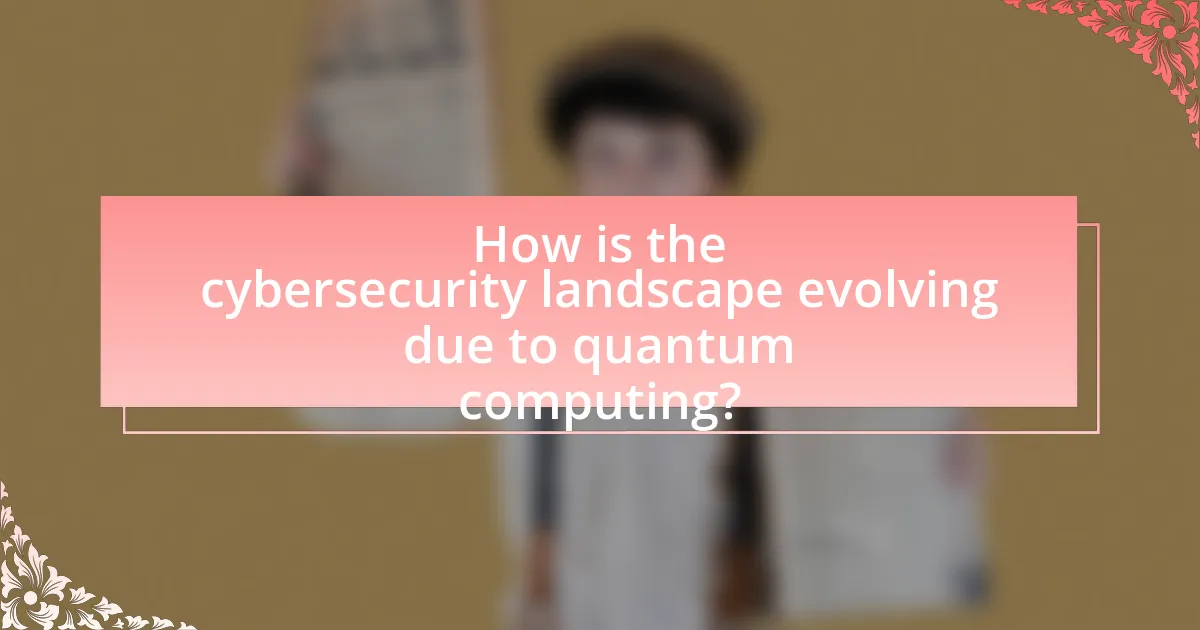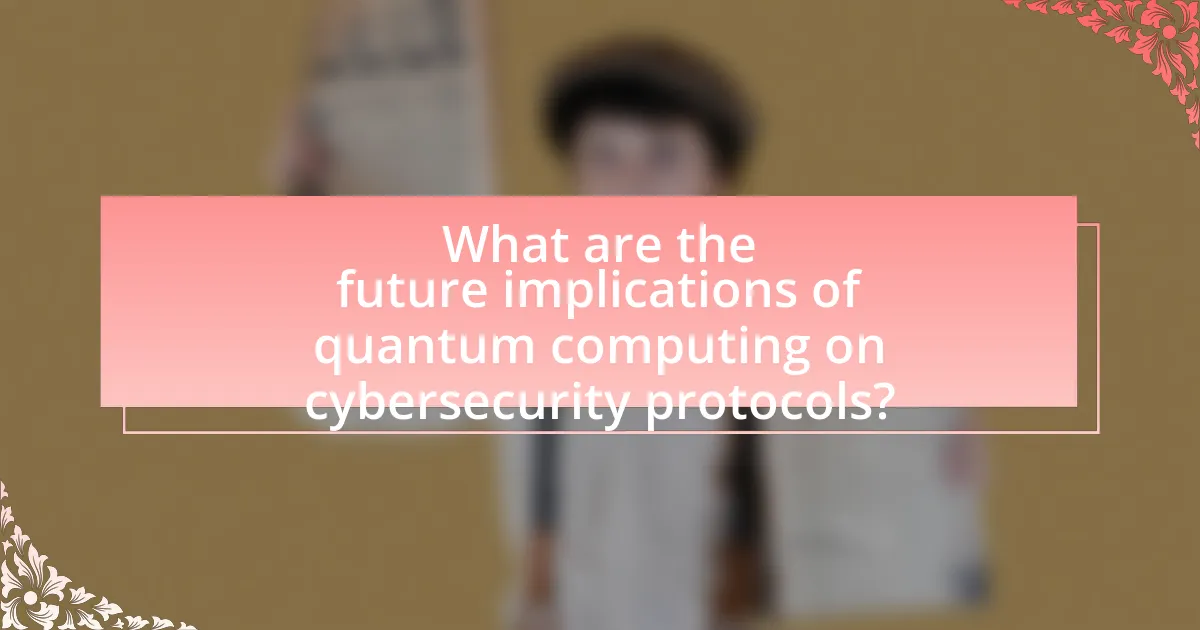Quantum computing poses a significant threat to current cybersecurity protocols by enabling the rapid decryption of traditional encryption methods, such as RSA and ECC, through algorithms like Shor’s algorithm. This article examines the fundamental differences between quantum and classical computing, the key principles of quantum mechanics that enhance computational power, and the vulnerabilities introduced to existing cybersecurity frameworks. It also discusses the urgent need for the development of quantum-resistant algorithms and the ongoing efforts by organizations like the National Institute of Standards and Technology (NIST) to establish post-quantum cryptography standards. Additionally, the article highlights the implications for data privacy and integrity, as well as best practices for organizations to safeguard against emerging quantum threats.

What is the Impact of Quantum Computing on Cybersecurity Protocols?
Quantum computing significantly threatens current cybersecurity protocols by enabling the rapid decryption of traditional encryption methods. Classical encryption relies on mathematical problems, such as factoring large integers, which quantum computers can solve efficiently using algorithms like Shor’s algorithm. This capability means that widely used encryption standards, such as RSA and ECC, could be compromised, rendering sensitive data vulnerable to unauthorized access. Research indicates that quantum computers could break these encryption methods in a matter of hours, compared to the years required by classical computers. Consequently, the cybersecurity landscape must evolve to incorporate quantum-resistant algorithms to safeguard data against potential quantum attacks.
How does quantum computing fundamentally differ from classical computing?
Quantum computing fundamentally differs from classical computing in its use of quantum bits, or qubits, which can exist in multiple states simultaneously due to superposition, whereas classical bits are limited to being either 0 or 1. This allows quantum computers to perform complex calculations at exponentially faster rates than classical computers, particularly for specific problems such as factoring large numbers, which is crucial for cryptography. For instance, Shor’s algorithm demonstrates that a quantum computer can factor a number in polynomial time, while the best-known classical algorithms require exponential time, highlighting the potential impact on cybersecurity protocols that rely on the difficulty of such mathematical problems.
What are the key principles of quantum computing?
The key principles of quantum computing include superposition, entanglement, and quantum interference. Superposition allows quantum bits (qubits) to exist in multiple states simultaneously, enabling parallel processing of information. Entanglement creates a strong correlation between qubits, such that the state of one qubit can depend on the state of another, regardless of distance, facilitating complex computations. Quantum interference is used to amplify the probability of correct outcomes while canceling out incorrect ones, enhancing the efficiency of quantum algorithms. These principles are foundational to the potential of quantum computing to solve problems that are intractable for classical computers, as evidenced by algorithms like Shor’s algorithm for factoring large numbers, which could disrupt current encryption methods.
How do these principles affect computational power?
Quantum computing principles significantly enhance computational power by leveraging superposition and entanglement, allowing for the simultaneous processing of multiple possibilities. This capability enables quantum computers to solve complex problems much faster than classical computers; for instance, Shor’s algorithm can factor large integers exponentially quicker than the best-known classical algorithms. Consequently, this increased computational power poses challenges for current cybersecurity protocols, as it can potentially break widely used encryption methods, necessitating the development of quantum-resistant algorithms.
Why is cybersecurity important in the context of quantum computing?
Cybersecurity is crucial in the context of quantum computing because quantum computers have the potential to break traditional encryption methods that secure sensitive data. Current cryptographic algorithms, such as RSA and ECC, rely on the difficulty of factoring large numbers or solving discrete logarithms, which quantum algorithms like Shor’s algorithm can efficiently solve. This capability poses significant risks to data integrity and confidentiality, as quantum computers could decrypt sensitive information, leading to data breaches and loss of privacy. The urgency for robust cybersecurity measures is underscored by the National Institute of Standards and Technology (NIST) actively working on post-quantum cryptography standards to safeguard against these emerging threats.
What vulnerabilities does quantum computing introduce to current cybersecurity protocols?
Quantum computing introduces significant vulnerabilities to current cybersecurity protocols, primarily by threatening the security of widely used encryption methods. Classical encryption algorithms, such as RSA and ECC, rely on the difficulty of factoring large numbers and solving discrete logarithm problems, respectively. Quantum computers, utilizing algorithms like Shor’s algorithm, can efficiently solve these problems, rendering traditional encryption methods insecure. For instance, a sufficiently powerful quantum computer could break RSA encryption in polynomial time, which is infeasible for classical computers. This capability poses a critical risk to data confidentiality and integrity, as sensitive information could be decrypted by adversaries with access to quantum technology.
How can quantum computing enhance cybersecurity measures?
Quantum computing can enhance cybersecurity measures by enabling the development of advanced cryptographic algorithms that are resistant to attacks from classical computers. This capability arises from quantum computers’ ability to process vast amounts of data simultaneously and solve complex mathematical problems more efficiently than traditional systems. For instance, quantum key distribution (QKD) utilizes the principles of quantum mechanics to create secure communication channels, ensuring that any eavesdropping attempts can be detected immediately. Research from the National Institute of Standards and Technology (NIST) highlights that quantum-resistant algorithms are essential for future-proofing data security against potential threats posed by quantum computing advancements.
What are the potential risks associated with quantum computing in cybersecurity?
Quantum computing poses significant risks to cybersecurity by potentially breaking current encryption methods. Traditional encryption algorithms, such as RSA and ECC, rely on the difficulty of factoring large numbers and solving discrete logarithms, respectively. Quantum computers can utilize Shor’s algorithm to efficiently solve these problems, rendering these encryption methods vulnerable. Research indicates that a sufficiently powerful quantum computer could decrypt sensitive data in seconds, which would compromise the confidentiality and integrity of information systems. The National Institute of Standards and Technology (NIST) has recognized this threat and is actively working on post-quantum cryptography standards to mitigate these risks.
How might quantum algorithms compromise encryption standards?
Quantum algorithms, particularly Shor’s algorithm, can compromise encryption standards by efficiently factoring large integers, which undermines the security of widely used public-key cryptosystems like RSA. Traditional encryption relies on the difficulty of factoring large numbers, but Shor’s algorithm can perform this task in polynomial time, making it feasible for quantum computers to break RSA encryption. This capability poses a significant threat to data security, as it could allow unauthorized access to sensitive information protected by current encryption methods.
What are the implications for data privacy and integrity?
The implications for data privacy and integrity in the context of quantum computing are significant, as quantum technologies can potentially break traditional encryption methods. Quantum computers can solve complex mathematical problems, such as factoring large integers, exponentially faster than classical computers, which undermines the security of widely used encryption algorithms like RSA and ECC. For instance, a quantum computer capable of executing Shor’s algorithm could decrypt sensitive data in seconds, exposing personal information and compromising data integrity. This vulnerability necessitates the development of quantum-resistant cryptographic protocols to safeguard data privacy and maintain integrity in a post-quantum world.

How is the cybersecurity landscape evolving due to quantum computing?
Quantum computing is fundamentally altering the cybersecurity landscape by introducing new vulnerabilities and necessitating the development of quantum-resistant cryptographic protocols. Traditional encryption methods, such as RSA and ECC, are at risk because quantum computers can efficiently solve problems that underpin these encryption techniques, potentially allowing unauthorized access to sensitive data. For instance, Shor’s algorithm demonstrates that a sufficiently powerful quantum computer could break RSA encryption in polynomial time, which is infeasible for classical computers. As a response, researchers and organizations are actively working on post-quantum cryptography, which aims to create algorithms that remain secure against quantum attacks. The National Institute of Standards and Technology (NIST) is currently in the process of standardizing these quantum-resistant algorithms, highlighting the urgency and importance of adapting cybersecurity measures to counteract the threats posed by quantum computing advancements.
What new cybersecurity protocols are being developed to counter quantum threats?
New cybersecurity protocols being developed to counter quantum threats include post-quantum cryptography (PQC) standards, which aim to secure data against potential quantum computing attacks. The National Institute of Standards and Technology (NIST) is actively working on standardizing PQC algorithms, with finalists such as Kyber, NTRU, and Saber being evaluated for their resilience against quantum decryption methods. These protocols utilize mathematical problems that remain difficult for quantum computers to solve, ensuring data integrity and confidentiality in a quantum computing era.
What is post-quantum cryptography and how does it work?
Post-quantum cryptography refers to cryptographic algorithms designed to be secure against the potential threats posed by quantum computers. These algorithms work by utilizing mathematical problems that are believed to be difficult for quantum computers to solve, such as lattice-based problems, hash-based signatures, and multivariate polynomial equations.
The security of traditional cryptographic systems, like RSA and ECC, relies on the difficulty of factoring large integers or solving discrete logarithm problems, which quantum computers could efficiently solve using algorithms like Shor’s algorithm. In contrast, post-quantum cryptographic algorithms are constructed to resist such attacks, ensuring data protection even in a future where quantum computing is prevalent. The National Institute of Standards and Technology (NIST) is actively working on standardizing post-quantum cryptographic algorithms to prepare for this eventuality.
Which organizations are leading the charge in developing these protocols?
The organizations leading the charge in developing cybersecurity protocols in the context of quantum computing include the National Institute of Standards and Technology (NIST), IBM, Google, and Microsoft. NIST is actively working on post-quantum cryptography standards, having initiated a process to evaluate and select quantum-resistant algorithms, with the first round of finalists announced in 2020. IBM and Google are also heavily invested in quantum research, focusing on creating secure quantum algorithms and cryptographic systems that can withstand quantum attacks. Microsoft contributes through its Quantum Development Kit and research initiatives aimed at integrating quantum-safe protocols into existing cybersecurity frameworks.
How are businesses adapting their cybersecurity strategies in light of quantum advancements?
Businesses are adapting their cybersecurity strategies by implementing quantum-resistant encryption methods to safeguard against potential threats posed by quantum computing. As quantum computers have the capability to break traditional encryption algorithms, organizations are transitioning to post-quantum cryptography standards, such as lattice-based and hash-based cryptography, which are believed to be secure against quantum attacks. For instance, the National Institute of Standards and Technology (NIST) has been actively working on standardizing post-quantum cryptographic algorithms, with several candidates selected for further evaluation, indicating a proactive approach by businesses to align with emerging standards. Additionally, companies are investing in research and development to enhance their security frameworks, ensuring they can withstand the evolving landscape of quantum threats.
What role does risk assessment play in these adaptations?
Risk assessment plays a critical role in adapting cybersecurity protocols to the challenges posed by quantum computing. It enables organizations to identify vulnerabilities in their current systems that quantum technologies could exploit, such as the potential for quantum computers to break traditional encryption methods. By evaluating the likelihood and impact of quantum threats, organizations can prioritize their resources and implement necessary changes, such as transitioning to quantum-resistant algorithms. This proactive approach is essential, as studies indicate that quantum computers could render existing cryptographic systems obsolete within the next decade, necessitating immediate and informed adaptations to maintain data security.
How can organizations prepare for the quantum computing era?
Organizations can prepare for the quantum computing era by investing in quantum-resistant cryptography and enhancing their cybersecurity protocols. As quantum computers have the potential to break traditional encryption methods, organizations must adopt algorithms that are designed to withstand quantum attacks, such as lattice-based cryptography, which is considered secure against quantum threats. The National Institute of Standards and Technology (NIST) is actively working on standardizing post-quantum cryptographic algorithms, providing a framework for organizations to follow. Additionally, organizations should conduct risk assessments to identify vulnerabilities in their current systems and develop a transition plan to implement quantum-safe technologies. This proactive approach will help mitigate risks associated with the advent of quantum computing.

What are the future implications of quantum computing on cybersecurity protocols?
Quantum computing will significantly disrupt current cybersecurity protocols by rendering many traditional encryption methods obsolete. As quantum computers become more powerful, they will be capable of breaking widely used cryptographic algorithms, such as RSA and ECC, which rely on the difficulty of factoring large numbers and solving discrete logarithm problems. Research indicates that a sufficiently advanced quantum computer could decrypt these algorithms in a matter of seconds, posing a severe threat to data security and privacy. Consequently, the cybersecurity landscape will need to transition towards quantum-resistant algorithms, such as lattice-based cryptography, to safeguard sensitive information against potential quantum attacks.
How will quantum computing shape the future of encryption methods?
Quantum computing will fundamentally alter encryption methods by enabling the rapid factorization of large integers, which threatens traditional encryption algorithms like RSA. This capability arises from quantum algorithms, such as Shor’s algorithm, which can solve problems in polynomial time that classical computers cannot efficiently tackle. As a result, encryption methods currently deemed secure may become vulnerable, necessitating the development of quantum-resistant algorithms. Research indicates that transitioning to post-quantum cryptography is essential to safeguard sensitive data against potential quantum attacks, as highlighted in the National Institute of Standards and Technology’s ongoing efforts to standardize quantum-resistant cryptographic algorithms.
What are the expected advancements in encryption technology?
Expected advancements in encryption technology include the development of quantum-resistant algorithms designed to withstand the capabilities of quantum computers. As quantum computing progresses, traditional encryption methods, such as RSA and ECC, face vulnerabilities due to their reliance on mathematical problems that quantum algorithms can solve efficiently. Research initiatives, such as the NIST Post-Quantum Cryptography Standardization project, aim to identify and standardize new cryptographic algorithms that are secure against quantum attacks. These advancements are crucial for ensuring data security in a future where quantum computing becomes mainstream, as evidenced by the increasing investment in quantum-safe technologies by governments and private sectors.
How might quantum key distribution change secure communications?
Quantum key distribution (QKD) could revolutionize secure communications by enabling the creation of cryptographic keys that are theoretically immune to eavesdropping. QKD utilizes the principles of quantum mechanics, specifically the behavior of photons, to ensure that any attempt to intercept the key will disturb the quantum states, alerting the communicating parties to the presence of an intruder. This capability is supported by the no-cloning theorem, which states that it is impossible to create an identical copy of an unknown quantum state, thereby enhancing security. As a result, QKD can provide a level of security that surpasses classical encryption methods, making it a critical advancement in the field of cybersecurity.
What best practices should organizations follow to safeguard against quantum threats?
Organizations should implement quantum-resistant cryptographic algorithms to safeguard against quantum threats. This involves transitioning from traditional cryptographic methods, such as RSA and ECC, which are vulnerable to quantum attacks, to post-quantum cryptography that can withstand the capabilities of quantum computers. The National Institute of Standards and Technology (NIST) is actively working on standardizing post-quantum cryptographic algorithms, which provides a reliable framework for organizations to follow. Additionally, organizations should conduct regular risk assessments to identify vulnerabilities in their current systems and update their security protocols accordingly. By staying informed about advancements in quantum computing and participating in industry collaborations, organizations can enhance their preparedness against potential quantum threats.
How can organizations implement post-quantum cryptography effectively?
Organizations can implement post-quantum cryptography effectively by adopting standardized algorithms that are resistant to quantum attacks, such as those recommended by the National Institute of Standards and Technology (NIST). NIST has been actively working on evaluating and standardizing post-quantum cryptographic algorithms, with the final selections expected to enhance security against potential quantum threats.
To ensure a smooth transition, organizations should conduct a thorough assessment of their current cryptographic systems, identifying areas where post-quantum algorithms can be integrated. This includes updating software and hardware to support new algorithms, as well as training personnel on the implications and implementation of these technologies.
Furthermore, organizations should engage in pilot programs to test the performance and interoperability of post-quantum solutions within their existing infrastructure. By following these steps, organizations can effectively safeguard their data against the future risks posed by quantum computing advancements.
What ongoing education and training should cybersecurity professionals pursue?
Cybersecurity professionals should pursue ongoing education and training in quantum computing, cryptography, and advanced threat detection techniques. As quantum computing evolves, it poses significant risks to traditional encryption methods, necessitating knowledge of quantum-resistant algorithms and protocols. For instance, the National Institute of Standards and Technology (NIST) is actively working on post-quantum cryptography standards, highlighting the importance of staying updated on these developments. Additionally, professionals should engage in certifications such as Certified Information Systems Security Professional (CISSP) and Certified Information Security Manager (CISM), which provide foundational and advanced knowledge relevant to emerging threats, including those posed by quantum technologies.


